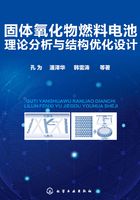
3.5 小结
针对目前缺乏准确的SOFC电极孔隙相曲率预测模型的现状,本章采用3D立方体堆积方法重构电极微观结构并研究了SOFC多孔电极孔隙的曲率,主要结论如下:
①从电极中抽取出代表体元来研究电极性质时,所取的体积边长至少要达到15倍孔隙特征尺寸才能充分代表电极有效性质;
②通过采用成熟的多孔电极扩散模拟手段和几何关系推导,最终获得的传统粉末烧结电极的曲率表达式为:

该式表明曲率是明确依赖于电极孔隙率的,在典型SOFC电极孔隙率范围内,曲率取值为1.3~4。
3D立方体堆积模型提供了一个准确的曲率预测工具,从某种程度上解决了目前曲率值取用不明确的问题,为准确描述电极微观形貌和电极中的传质过程提供了有价值的参考。而为了减小孔隙曲率,在电极烧结过程中增加造孔剂以增加孔隙率是一种方法,但孔隙率和孔隙曲率的调节还应兼顾固体相的导电性能。
参考文献
[1]Sercombe J,Vidal R,Gallé C,et al.Experimental study of gas diffusion in cement paste[J].Cement and Concrete Research,2007,37(4):579-588.
[2]Kong W,Zhu H,Fei Z,et al.A modified dusty gas model in the form of a Ficks model for the prediction of multicomponent mass transport in a solid oxide fuel cell anode[J].Journal of Power Sources,2012,206(5):171-178.
[3]Zamel N,Li X.Effective transport properties for polymer electrolyte membrane fuel cells – With a focus on the gas diffusion layer[J].Progress in Energy and Combustion Science,2013,39(1):111-146.
[4]Yuan J,Sundén B.On mechanisms and models of multi-component gas diffusion in porous structures of fuel cell electrodes[J].International Journal of Heat and Mass Transfer,2014,69(5):358-374.
[5]Bruggeman D.Calculation of various physics constants in heterogenous substances I dielectricity constants and conductivity of mixed bodies from isotropic substances[J].Ann Phys,1935,24(7):636-664.
[6]Cooper S J,Kishimoto M,Tariq F,et al.Microstructural analysis of an LSCF cathode using in situ tomography and simulation[J].ECS Transactions,2013,57(1):2671-2678.
[7]Wargo E A,Kotaka T,Tabuchi Y,et al.Comparison of focused ion beam versus nano-scale X-ray computed tomogra-phy for resolving 3-D microstructures of porous fuel cell materials[J].Journal of Power Sources,2013,241(5):608-618.
[8]Joos J,Carraro T,Weber A,et al.Reconstruction of porous electrodes by FIB/SEM for detailed microstructure modeling[J].Journal of Power Sources,2011,196(17):7302-7307.
[9]Bertei A,Nucci B,Nicolella C.Microstructural modeling for prediction of transport properties and electrochemical performance in SOFC composite electrodes[J].Chemical Engineering Science,2013,101(5):175-190.
[10]Joos J,Ender M,Carraro T,et al.Representative volume element size for accurate solid oxide fuel cell cathode reconstructions from focused ion beam tomography data[J].Electrochimica Acta,2012,82(5):268-276.
[11]Grew K N,Chu Y S,Yi J,et al.Nondestructive nanoscale 3D elemental mapping and analysis of a solid oxide fuel cell anode[J].Journal of The Electrochemical Society,2010,157(6):B783-B792.
[12]Berson A,Choi H W,Pharoah J G.Determination of the effective gas diffusivity of a porous composite medium from the three-dimensional reconstruction of its microstructure[J].Physical Review E,2011,83(2):026310-1-12.
[13]Rüger B,Joos J,Weber A,et al.3D electrode microstructure reconstruction and modelling[J].ECS Transactions,2009,25(2):1211-1220.
[14]Rüger B,Weber A,Ivers-Tiffee E.3D-modelling and performance evaluation of mixed conducting(MIEC) cathodes[J].ECS Transactions,2007,7(1):2065-2074.
[15]Haffelin A,Joos J,Ender M,et al.Time-dependent 3D impedance model of mixed-conducting solid oxide fuel cell cathodes[J].Journal of The Electrochemical Society,2013,160(8):F867-F876.
[16]Haffelin A,Niedrig C,Wagner S F,et al.Three-dimensional performance model for oxygen transport membranes[J].Journal of The Electrochemical Society,2014,161(14):F1409-F1415.
[17]Cai Q,Adjiman C S,Brandon N P.Modelling the 3D microstructure and performance of solid oxide fuel cell electrodes:Computational parameters[J].Electrochimica Acta,2011,56(16):580-5814.
[18]Joshi A S,Grew K N,Peracchio A A,et al.Lattice Boltzmann modeling of 2D gas transport in a solid oxide fuel cell anode[J].Journal of Power Sources,2007,164(2):631-638.
[19]Guan Y,Song X,Liu G,et al.Lattice-Boltzmann modeling of gas transport in Ni-Yttria-stabilized zirconia anodes during thermal cycling based on X-ray computed tomography[J].Electrochimica Acta,2014,121(5):386-393.
[20]Iwai H,Shikazono N,Matsui T,et al.Quantification of SOFC anode microstructure based on dual beam FIB-SEM technique[J].Journal of Power Sources,2010,195(4):955-961.
[21]Sanyal J,Goldin G M,Zhu H,et al.A particle-based model for predicting the effective conductivities of composite electrodes[J].Journal of Power Sources,2010,195(19):6671-6679.
[22]Laurencin J,Quey R,Delette G,et al.Characterisation of solid oxide fuel cell Ni–8YSZ substrate by synchrotron X-ray nano-tomography:from 3D reconstruction to microstructure quantification[J].Journal of Power Sources,2012,198(5):182-189.
[23]Kim J W,Virkar A V,Fung K Z,et al.Polarization effects in intermediate temperature,anode-supported solid oxide fuel cells[J].Journal of The Electrochemical Society,1999,146(1):69-78.
[24]Gostovic D,Smith J,Kundinger D,et al.Three-dimensional reconstruction of porous LSCF cathodes[J].Electrochemical and Solid-State Letters,2007,10(12):B214-B217.
[25]Kishimoto M,Miyawaki K,Iwai H,et al.Effect of composition ratio of Ni-YSZ anode on distribution of effective three-phase boundary and power generation performance[J].Fuel Cells,2013,13(4):476-486.
[26]Gunda N S K,Choi H W,Berson A,et al.Focused ion beam-scanning electron microscopy on solid-oxide fuel-cell electrode:Image analysis and computing effective transport properties[J].Journal of Power Sources,2011,196(7):3592-3603.
[27]Kishimoto M,Iwai H,Saito M,et al.Quantitative evaluation of solid oxide fuel cell porous anode microstructure based on focused ion beam and scanning electron microscope technique and prediction of anode overpotentials[J].Journal of Power Sources,2011,196(10):4555-4563.
[28]Usseglio-Viretta F,Laurencin J,Delette G,et al.Quantitative microstructure characterization of a Ni-YSZ bi-layer coupled with simulated electrode polarisation[J].Journal of Power Sources,2014,256(5):394-403.
[29]Gawel D A W,Pharoah J G,Beale S B.Development of a SOFC performance model to analyze the powder to power performance of electrode microstructures[J].ECS Transactions,2015,68(1):1979-1987.
[30]Zhang Y,Xia C,Ni M.Simulation of sintering kinetics and microstructure evolution of composite solid oxide fuel cells electrodes[J].International Journal of Hydrogen Energy,2012,37(4):3392-3402.
[31]Choi H-W,Gawel D,Berson A,et al.Comparison between FIB-SEM experimental 3-D reconstructions of SOFC electrodes and random particle-based numerical models[J].ECS Transactions,2011,35(1):997-1005.
[32]Zheng K,Zhang Y,Li L,et al.On the tortuosity factor of solid phase in solid oxide fuel cell electrodes[J].International Journal of Hydrogen Energy,2015,40(1):9-665.
[33]Matyka M,Khalili A,Koza Z.Tortuosity-porosity relation in porous media flow[J].Physical Review E,2008,78(2).
[34]Lanfrey P Y,Kuzeljevic Z V,Dudukovic M P.Tortuosity model for fixed beds randomly packed with identical particles[J].Chemical Engineering Science,2010,65(5):1891-1896.
[35]Nikitsin V I,Backiel-Brzozowska B.Determination of capillary tortuosity coefficient in calculations of moisture transfer in building materials[J].International Journal of Heat and Mass Transfer,2013,56(1-2):30-34.
[36]Li P W,Chyu M K.Simulation of the chemical/electrochemical reactions and heat/mass transfer for a tubular SOFC in a stack[J].Journal of Power Sources,2003,124(2):487-498.